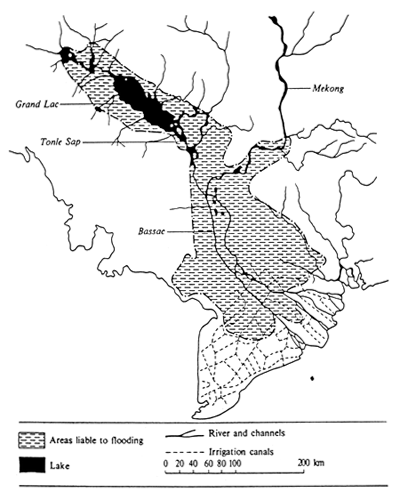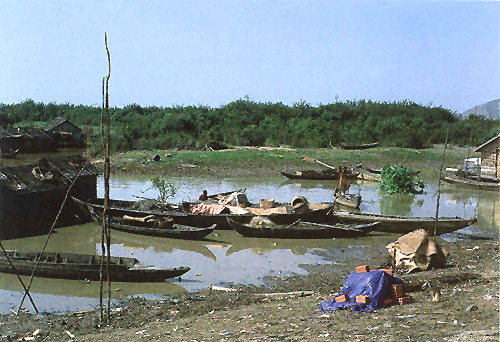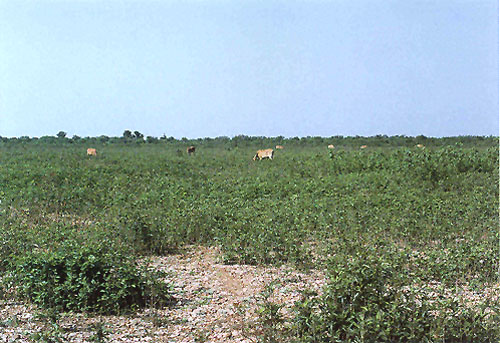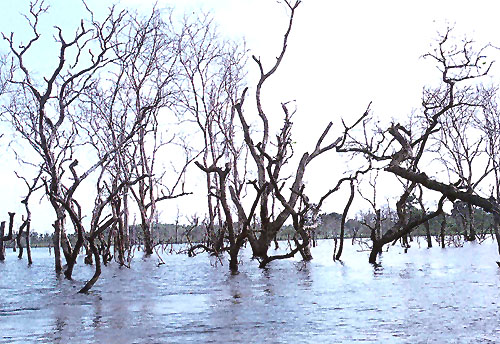Inundated forests, flooded forests, or flood forests are the names given to forested areas periodically flooded during the flood season. They are present largely in the tropical countries of Latin America (e.g. igapo and varzea - see Section 8), in tropical Africa, in tropical Asia, and the island of New Guinea, but forests along many rivers in subtropical and temperate zones are also adapted to withstand longer term flooding. Inundated forests represent an important habitat for fish, which find among the flooded trees a temporary breeding and nursing habitat as well as rich feeding grounds. Their importance for freshwater capture fisheries has been emphasized in a number of publications.
New reservoirs frequently permanently flood the existing forests as clearing forests on large areas is often uneconomic. Leaves are the first part of trees which undergo decomposition, but also attract herbivorous fish. The decay of the wooden parts is slow, and may last hundreds of years. Trees which are regularly exposed to drawdown, are subjected to the attack of wood-burrowing insects and fungus, and when submersed, attacked by microorganisms, and in some water bodies also by aquatic insects the larvae of which seek shelter in burrows. In the euphotic zone, the submersed surfaces are colonized by epiphyton. Both the epiphyton and the associated micro- and macroinvertebrates are an important food of fish.
In some countries forest trees are resistant to long-term flooding. Such forests are present in the Amazon, in southeastern Asia, Papua New Guinea, and the USA. During high water levels the flooded forests provide habitat and submersed surfaces for periphyton production. In Cambodia, around the Great Lake (Tonle Sap) (Fig. 40), in 1990, inundated forests and their degraded remnants covered around 500 000 ha. Satellite imagery showed that 361 700 ha were flooded evergreen forest, 152 200 ha a mosaic of flooded forest, swampy vegetation and fallow land.

Fig. 40. The delta of the Mekong River, with the Great Lake on the Tonle Sap River. (From Welcomme, 1985).
As a result of human activities around the lake, the forest has been rapidly diminishing, with encroachment of agriculture, paralleled by clearing of the natural vegetation, having the greatest impact. Grazing cattle in the revegetating forest prevents its recovery (Photos 17 and 18).

PHOTO 17: Remnants of flood forest behind a fishing village, Great Lake, Cambodia.
The inundated forest of the Great Lake, and to a lesser extent the inundated forest of the Tonle Sap and Mekong rivers, are considered to be essential for maintaining the existing level of inland fishery production in Cambodia (Csavas et al., 1994). About 90 percent of the total freshwater stocks follow the inundation spawning pattern and many of fish species breed in the inundated forests, with the lake water rising during the peak of floods by 10 to 14 m, expanding the lake surface area from 2 500 km2 to 11 000 km2, exceptionally to 13 000 km2. Since the 1950s the exploitation of inundated forests around the Great Lake has accelerated under the severe pressure for agricultural land development, for charcoal and firewood production, smoking fish, construction of fish traps, for firing brick kilns, and also due to the use of branches for brush parks (fish attraction devices). As no solid information exists on the significance of these inundated forests on the individual species of fish, it is difficult to assess the damage which the rapid exploitation of the forests has caused to fish stocks. Some areas of the degraded forest are now covered by regrowth of different species with a height up to 4 m. This may have ameliorated the detrimental impact of deforestation on fish populations. A pilot project was initiated in the 1990s on the rehabilitation of some parts of the forest, aiming at replanting water-tolerant trees. The results are yet to be fully evaluated.

PHOTO 18: Cattle grazing on re-vegetating forest, Great Lake, Cambodia.
In Lake Luar, the largest lake on the middle Kapuas River in Indonesia, close to the Sarawak border, the presence of inundated forests is believed to sustain a high fish production in the otherwise nutrient impoverished black water (Petr, 1993).
In the lowlands of the Sepik and Ramu rivers in Papua New Guinea more than two thirds of the estimated 33 000 km2 of floodplains are covered by seasonally inundated floodplain forest. In addition to that, at altitudes below 200 m there is an estimated 55 000 km of permanent river channel wider than 2.5 m, the majority of which is bordered by dense forest, flooding in the rainy season at altitudes below 50 m (Coates, 1993). Inputs of vegetable matter, especially fruits, nuts and other seeds into rivers, lakes and flooded forest from this large expanse of terrestrial vegetation are considered to be relatively high, and Coates believes that the flooded forest in Papua New Guinea broadly supplies an equivalent quantity of plant products as produced by flood forests of the Amazon. The only indigenous species utilising this resource is the halfbeak Zenarchopterus kampeni which feeds on very small seeds, but mainly on insects, falling onto the water surface from surrounding vegetation (Coates and Zwieten, 1992). It was therefore decided to introduce from Malaysia the fruit-eating south American fish species Colossoma bidens (=Piaractus brachypomum). The introductions were made between 1995 and 1997 (Coates, 1997). The results of the introduction are not known.
In the Brazilian Amazon, the temporarily inundated forests extend over an area of some 70 000 km2 (Pires, 1972). In a study by Waldhoff et al. (1996) on white water (varzea) and black water (igapo) 23 fish species (22% of species captured in the area) from inundated forests fed on fruits and seeds in varzea, and 34 species (13% of species) on the same in black waters. Whitewater and blackwater rivers are not completely distinct entities with separated fish faunas, since individual fish of many species move from one type of water to another seasonally and during the course of their life history (Lowe-McConnell, 1987) (Fig. 41).

Fig. 41. Seasonal changes in water level in Amazon tributaries and associated fish movements. On falling flood adult fish move from flood forest (A), down nutrient-poor tributaries and up-stream in main whitewater river, sheltering along wooded shores (B) at low water. Juveniles move from shrinking floodplain lakes (C) and upriver. On rising flood adults move to spawning areas (D) in whitewater river and after spawning move up tributaries into flood forest to feed (E). Newborn young find nursery areas in floodplain lakes (F). (From Lowe-McConnell, 1987).
Altogether, in the Amazonia about 200 fish species of fish feed on fruits and seeds of the seasonally inundated forests. The most common of them is tambaqui (Colossoma macropomum), a good table fish, which feeds almost entirely on fruits and seeds of the inundated forests during the highwater period, while starving in the main river channel during low water. Food and seed production in the inundated forests is much higher than in other forests (Revilla, 1991). Waldhoff et al. (1996) estimate that of the total of 3.5 billion trees in the inundated forests in Amazonia about a quarter produce important fish food every year during high water. If only 10% of this production is consumed by fish, and assuming a conversion factor of 1:10, the fruit output corresponds to a commercial fish production of between 160 000 and 530 000 tons y-1.
The floodplains in the Central Amazon Region close to cities and towns are now intensively used for agriculture. The varzea forest has been removed and large areas are used for grazing (Conserva and Piedade, 1998). Bayley (1989) reported 50% of the forest near Manaus has been already cleared. Deforestation rate is larger further downstream. Araujo-Lima et al. (1998) estimated the economic value of Colossoma macropomum for the economy of Manaus, the largest city in Central Amazon. In 1993–1994 it was estimated at US$ 8.3 million. Flooded forest revenue related to tambaqui production was larger than poultry and rubber production in the Amazonas State, and close to the value recorded for the logging industry. Araujo-Lima et al. concluded that conservation of the flooded forest habitats is of critical importance for the future of the local economy.
While inundated herbaceous plants in a new reservoir decompose usually within a year, submersed trees may remain intact for over 100 years, especially those that are never exposed to the atmosphere (Jenkins, 1970). Submersed and partly emerged trees and brush provide surface area for periphyton and the associate invertebrate fauna. In some reservoirs, the primary production of periphyton may exceed that of plankton, but exact data are not yet available. Where dense enough as well as where they are standing in shallow water, trees also provide shelter for the establishment of macrophytes which they protect from wave action. The habit of some fish species to deposit eggs on underwater surfaces provides such species with an enlarged suitable breeding and nursery habitat. Many centrarchids and some other fish of North America have been observed to build nests on inundated herbaceous vegetation, trees, brush and stumps (Ploskey, 1985). For example, the abundance of yellow perch (Perca flavescens) was directly correlated with the availability of brush. Davis and Hughes (1971) found that in Bussey Lake, a reservoir in Louisiana, large bluegills and largemouth bass were more abundant in areas with trees than in those without trees. Reservoir coves with submersed trees also have a higher fish standing crop than coves without inundated trees, as found in a study of Willis and Jones (1984) in seven Kansas reservoirs.
In Parakrama Samudra reservoir in Sri Lanka, prior to submergence, large areas were covered by trees. These are now in various degrees of degeneration. Although the trees represent a danger to fishing gear, fishermen prefer setting the nets among trees as fish tend to congregate in such areas and this makes commercial fishing viable. De Silva (1988) suggested to leave approximately 50 % of the forest cover of the future reservoir bed in new reservoirs, established in forested areas. The retention of some uncleared areas for fisheries development in new reservoirs has also been supported by Ploskey (1985), who evaluated the effect of preimpoundment clearing on reservoir ecology and fisheries in North America.
In the Volta Lake in Ghana, West Africa, much of the 8 480 km2 flooded by this reservoir was originally tree-covered (Photo 19).
After flooding, trees in the shallows were rapidly colonized by the mayfly Povilla adusta, the nymphs of which burrow into the bark and in soft wood tree species (Petr, 1970, 1986a). The filling of the reservoir extended over a period of four years. As the water was advancing and rising, the Povilla nymphs attacked the newly submersed trees. Of the littoral plants which later appeared, they preferred the hollow-stemmed Polygonum senegalense, which provided readily available protective cavities. During the night the nymphs left the cavities to filter-feed on planktonic algae and graze periphyton on the surface of the dead trees and aquatic macrophytes. A primary consumer, Povilla became an important link in the food chain between algae and fish, and its mass occurrence has been conducive to the maintenance of many fish stocks, especially the insectivorous Alestes, Eutropius and Schilbe, which in 1967 constituted 81% of fish landings by number in the north of the reservoir. Stomachs of the characid Brycinus leuciscus also contained a high proportion of Povilla. Mormyrids Mormyrus macrophthalmus and Mormyrops deliciosus preferred the big nymphs of Povilla and dragonflies to chironomid larvae, the first fish species largely being limited to the riverine reach of the reservoir (Petr, 1968a). When Povilla became most abundant in the reservoir, i.e. in the third year after flooding (1967), in the characid Alestes baremoze it was present in 65% of the stomachs, representing 56% of the total food eaten (Petr, 1974). Povilla was also the dominant food of some Brycinus macrolepidotus, but more commonly this species was omnivorous, with plant material a regular component of food in its stomach during the rising reservoir water level. The pelagic fish Pellonula leonensis and Physailia pellucida also fed on this mayfly, which represented the major food item for the first fish (Reynolds, 1970). Altogether 14 species of fish have been found to feed on Povilla in Volta Lake. With the full development of Povilla on/in inundated trees of Lake Volta, there appeared to be no indication of any interspecific or intergeneric competition for food among the omnivores and predators (Petr, 1974).

PHOTO 19: Flooded trees at margins of Volta Lake, Ghana.
The fresh mass of Povilla nymphs from trees ranged from 6–69 g m-2 of bark. This is in excess of the zoobenthic maximum standing crop (wet weight) of 6.1 g m-2 found in the most productive part of Volta Lake. In Lake Kariba, when comparing the aquatic invertebrates of inundated trees with those of benthos and aquatic vegetation, McLachlan (1974) found just the opposite: trees formed the poorest of the substrates with the lowest mean faunal weight, which was about a third of that of benthos, and about 18 fold less than that found in aquatic vegetation. The difference could be due to the presence of predominantly hard wood trees with little bark in Lake Kariba, while the submersed trees of the tropical forest and savanna in Volta Lake were rich in thick bark and many trees had soft wood, which became rapidly perforated by the burrows of Povilla. In Volta Lake Povilla formed 90% of the total standing crop of aquatic macroinvertebrates associated with the bark/wood of submersed trees, followed by the chironomid Polypedilum larvae (Petr, 1970). One may conclude that in Volta Lake the massive development of Povilla on inundated trees has contributed to maintaining high fish landings from this lake.
Even prior to understanding the significance of the presence of dead trees in reservoirs for fish production through food chain cascade, in some parts of Africa the fish production in shallow water bodies was artificially increased by establishing brushparks. These are made of brush cut around the lake or a lagoon, which, when submersed, will provide surfaces for periphyton and its associated aquatic invertebrate fauna, as well as functioning as fish-attracting devices. The method, first described in Benin, West Africa, under the name acadja (Welcomme, 1972), is now widespread. Annual fish yields vary from 2 t ha-1 with fishing intervals of 3 to 4 days, to up to 17 t ha-1 with an interval of 70 days (Welcomme and Kapetsky, 1981). The requirement of wood for acadjas is about 10 t yr-1 and this may be detrimental to the shoreline brushes and trees. As a widespread use of acadja leads to rapid deforestation around the water body, studies have been made of trees with a reasonable resistance to underwater decay, which could be grown in plantations. The use of brushparks is also common in the Niger River, in some countries of Asia, for example in Indonesia (see Section 7.1), in the Mekong River, and in Ecuador (Welcomme, 1985).
In tropical and subtropical countries, the highest water level in a reservoir is normally achieved at the end of floods. The drawdown period follows, during which areas of various extent are exposed. The magnitude differs in different lakes, but may be substantial, as for example in reservoirs used for irrigation purposes, or some reservoirs constructed for hydropower production. Depending on the type of soil exposed and the amount of precipitation available during the exposure, the drawdown area develops terrestrial vegetation. McLachlan (1971) and McLachlan (1974) based on their observations from Lake Kariba, a reservoir in Africa, noted that drawdown functions as part of the lake/reservoir edge nutrient cycle. Plants which grow on the exposed littoral may be grazed by wildlife or domestic animals, which enrich the drawdown area with manure. The magnitude of drawdown in man-made lakes may be substantial. After the reservoir Lake Volta filled up completely for the first time in 1968, the drawdown in 1969 exposed approximately 10% of the total reservoir area, this being approximately 80 000 ha (Petr, 1975). During the exposure many plants become established and grow to maturity, to be flooded by the rising water level during the next flood season. When reflooded, their surfaces provide substrate for periphyton and numerous aquatic invertebrates, and the subsequent decomposition of the plants results in high nutrient levels in the shallow water. Water above the reflooded land, enriched by dung of terrestrial mammals grazing on plants during the drawdown period, shows an increase in water conductivity, alkalinity and potassium. This leads to local increases in primary and secondary production. The regular drawdown and reflooding is equivalent to ‘flood pulse’ on natural floodplains, which is responsible for their high productivity. In Volta Lake this reservoir flood pulse has probably played an important role in the high fish production of this reservoir. In Lake Naivasha reflooding of the drawdown led to an explosive development of ostracods, and the same was observed in experiments when containers of young papyrus transplanted directly from the lake were flooded (Gaudet, 1977). The rapid build-up of ostracods is accompanied by death and decay of the drawdown flora, increases in other invertebrates, appearance of juvenile fish, increase in fishing bird activity etc. Offshore primary production also increases as the water level rises. In short, the reflooding phase coincides with a period of increased production in a water body.
In Hong Kong, China, analysis of five species of fish (Carassius auratus, Hemiculter bleekeri, Culter erythropterus, Cirrhina molitorella, Oreochromis mossambicus) showed that after a rise in water level in Plover Cove reservoir the flooded terrestrial vegetation (sedges, Polygonaceae, and grasses such as Echinochloa sp.) became their major dietary items (Dudgeon, 1983). In C. molitorella and O. mossambicus the terrestrial macrophytes were the dominant component of their stomach-gut contents. The information collected strongly suggested that fish migrated into the marginal zone to feed upon the flooded material.
Management approach, using replanting and restocking, has been applied on the oligotrophic Paizhong Lake on the lowlands of the Yangtze River. This lake originally had a dense growth of macrophytes. After overstocking it with grass carp in 1975, the macrophytes virtually disappeared by 1979. By the 1980s, the grass carp production was negligible, and it was therefore decided to rehabilitate the aquatic plants by sowing the littoral zone with Echinochloa crus-galli (213 ha) and Zizania latifolia (5.5 ha). Within two months the vegetation biomass reached 10 tons ha-1. The plants were inundated by rising the water level, and subsequently fish were stocked, including grass carp, bottom-feeding and planktivorous species. Herbivorous fish were stocked first, to utilize the aquatic plants and to remineralize the nutrient from aquatic plants into the environment. Bottom-feeding fish were stocked to feed on detritus from the plants and, finally, planktivores were added. Under this system, the production reached was 460 kg ha-1, a 62% increase in production on years when there was no vegetation in the marginal zone. This approach is now widely adopted in China lakes (Zhang and Chang, 1994).